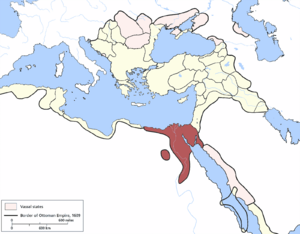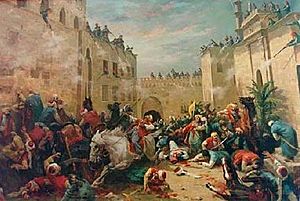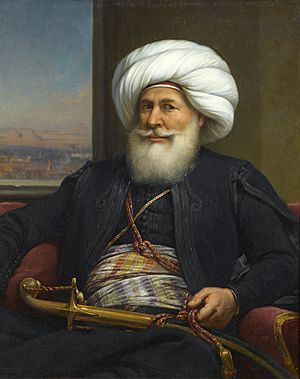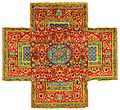Ottoman Egypt facts for kids
Quick facts for kids Ottoman Egypt
إيالة مصر (Arabic)
Iyalat Misr ایالت مصر (Ottoman Turkish) Eyālet-i Mıṣr |
|||||||||||||||||||
|---|---|---|---|---|---|---|---|---|---|---|---|---|---|---|---|---|---|---|---|
| Ottoman Province (1517–1805) Autonomous Province (1805–1914) |
|||||||||||||||||||
| 1517–1914 | |||||||||||||||||||
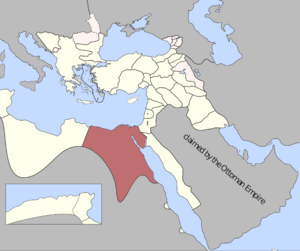 Map of the Eyalet of Egypt in 1795 |
|||||||||||||||||||
 Expansion of the Eyalet under Muhammad Ali and his sons |
|||||||||||||||||||
| Capital | Cairo | ||||||||||||||||||
| Demonym | Egyptians | ||||||||||||||||||
| Population | |||||||||||||||||||
|
• 1700
|
2,335,000 | ||||||||||||||||||
|
• 1867
|
6,076,000 | ||||||||||||||||||
| Government | |||||||||||||||||||
| Grand Vizier | |||||||||||||||||||
|
• 1857–1858
|
Zulfiqar Pasha (first) | ||||||||||||||||||
|
• 1866–1867
|
Sherif Pasha (last) | ||||||||||||||||||
| Historical era | Early modern period | ||||||||||||||||||
|
• Ottoman conquest
|
1517 | ||||||||||||||||||
|
• French Campaign
|
1798–1801 | ||||||||||||||||||
|
• Rise of Muhammad Ali
|
1801–1805 | ||||||||||||||||||
| 1820–1822 | |||||||||||||||||||
| 1831–1833 | |||||||||||||||||||
| 1867 | |||||||||||||||||||
| 1882 | |||||||||||||||||||
| 1914 | |||||||||||||||||||
|
|||||||||||||||||||
Ottoman Egypt was a part of the Ottoman Empire for a long time. It started in 1517 after the Ottomans conquered Mamluk Egypt. They ruled Egypt as a province, which they called an Eyalet.
Even though it was officially an Ottoman province until 1914, Egypt slowly became more independent during the 1800s. By 1882, the British had taken control, even though Egypt was still technically part of the Ottoman Empire.
Egypt was always a tricky place for the Ottoman Sultans to control. This was because the Mamluks, a powerful group of soldiers who had ruled Egypt for centuries, still had a lot of power. Egypt stayed partly independent under the Mamluks until Napoleon Bonaparte's French army invaded in 1798.
After British and Turkish forces kicked out the French in 1801, an Albanian military leader named Muhammad Ali Pasha took control in 1805. He set up a state that was almost independent.
Egypt, under the Muhammad Ali dynasty, was still officially an Ottoman province. But in reality, it acted like its own country. It even fought two wars against the Ottoman Empire in 1831–33 and 1839–41. In 1867, the Ottoman Sultan recognized Egypt as an autonomous vassal state, or Khedivate.
Egypt remained a de jure (officially) Ottoman province until November 5, 1914. At that time, the Sultanate of Egypt became a British protectorate. This happened because the Ottoman Empire joined World War I on the side of the Central Powers.
Contents
History of Ottoman Egypt
Early Ottoman Rule
After conquering Egypt in 1517, the Ottoman Sultan Selim I left the country. The first Ottoman governor was Yunus Pasha. However, the Sultan soon found out that Yunus Pasha was taking bribes. So, the job was given to Hayır Bey, a former Mamluk governor.
The early years of Ottoman Egypt were a struggle for power. The Mamluks and the Ottoman Sultan's representatives constantly competed. The Mamluks were allowed to keep their land and influence. They even kept their positions as leaders of 12 regions called sanjaks.
Under the next Sultan, Suleiman the Magnificent, two councils were created. These councils, called the Greater Divan and Lesser Divan, included army and religious leaders. They were meant to help the Ottoman governor.
The Ottoman rulers often changed the governor of Egypt very quickly, sometimes after only a year. The fourth governor, Hain Ahmed Pasha, tried to become an independent ruler. He even had coins made with his own name on them. But his plans failed, and he was captured and executed.
Challenges and Mamluk Power (1527–1700)
In 1527, the first official survey of Egypt under Ottoman rule was done. This survey divided Egyptian lands into four types: the Sultan's land, lands given as gifts, land for the army, and land for religious groups.
The frequent changes in government meant the army became hard to control. By the early 1600s, soldiers often rebelled. In 1604, the governor Maktul Hacı Ibrahim Pasha was even murdered by the soldiers. These rebellions often happened because governors tried to stop "tulbah," which were forced payments soldiers demanded from people.
In 1609, a big fight broke out between the army and the governor, Kara Mehmed Pasha. The soldiers even tried to choose their own sultan. But Kara Mehmed Pasha defeated them. On February 5, 1610, he entered Cairo in victory. He executed the rebellion's leaders. This event was so important that some historians called it a "second conquest" of Egypt for the Ottomans. After this, Kara Mehmed Pasha made big financial changes to make taxes fairer.
As the Ottoman Empire faced problems, the local Mamluk leaders (called beys) started to control more of Egypt's government. They managed the treasury and had a lot of power over local areas. Mamluk beys also held important army positions. This gave them the power to challenge the Ottoman governors.
Officers in the Ottoman Egyptian army were chosen locally. They had strong ties to rich Egyptian families. Because of this, a Mamluk leader named Ridwan Bey effectively ruled Egypt from 1631 to 1656. The Sultan often sided with the troops against the governor. Also, new governors often made the old governor pay a large fine before leaving Egypt.
The 17th century also saw two main Mamluk groups, the Faqari and the Qasimi, constantly fighting for power. The Faqari were linked to the Ottoman cavalry and used white colors. The Qasimi were linked to Egyptian troops and used red colors. By the end of the century, these groups were very strong and influenced the Ottoman governors a lot.
Later Ottoman Rule and French Invasion
Mamluk Dominance and Ali Bey (1707–1798)
By the 1700s, the Mamluk beys became more important than the Ottoman governor. Two Mamluk positions, the Shaykh al-Balad and the Amir al-hajj, became the real leaders of Egypt.
In 1707, a fight broke out between two Mamluk groups, the Qasimites and the Fiqarites. The Shaykh al-Balad, Qasim Iywaz, was killed, and his son Ismail took his place. Ismail held this office for 16 years and managed to unite the two Mamluk groups.
After more power struggles and assassinations among Mamluk leaders, Ali Bey al-Kabir rose to power. He became famous for defending trade caravans. He spent eight years gathering Mamluks and supporters. He eventually became Shaykh al-Balad in 1760. After some struggles, he gained the support of the Ottoman Sultan and was reinstated.
In 1769, Ali Bey found out the Ottoman Sultan secretly ordered his execution. He told the beys that the order was for all of them, and urged them to fight for independence. The beys supported him, and Egypt declared itself independent from the Ottomans. Ali Bey worked to make his rule stronger, sending armies to fight tribes and improve the government. His son-in-law, Abu-'l-Dhahab, conquered parts of Yemen and Syria. By 1771, much of the Arabian Peninsula was under Ali Bey's control. He even had coins made with his own name.
However, Abu-'l-Dhahab secretly made a deal with the Ottoman Sultan to return Egypt to Ottoman control. He left Syria and marched to Cairo. Ali Bey tried to defend himself but was defeated and captured. He died seven days later.
After Ali Bey's death, Egypt became an Ottoman province again. Abu-'l-Dhahab became the Shaykh al-Balad. After Abu-'l-Dhahab died, Murad Bey and Ibrahim Bey eventually ruled Egypt together. They maintained their joint rule until 1786, when the Ottoman Empire sent an army to restore its power. Murad and Ibrahim fled. Ismail Bey was made Shaykh al-Balad again.
In 1791, a terrible plague hit Cairo, killing Ismail Bey. Ibrahim Bey and Murad Bey were called back and resumed their joint government. They were still in power in 1798 when Napoleon Bonaparte entered Egypt.
French Occupation of Egypt (1798–1801)
Reasons for the Invasion
The French said they invaded Egypt to restore the Ottoman Sultan's power and get rid of the Mamluks. Napoleon Bonaparte claimed he respected God, Muhammad, and the Qur'an. He said all people were equal and that important jobs in Egypt would be open to everyone.
The French wanted towns that surrendered to fly both the Ottoman and French flags. After the Battle of Embabeh (also called the Battle of the Pyramids), where the Mamluk armies were defeated, people looted the Mamluk leaders' homes. A group from Al-Azhar Mosque went to Bonaparte to understand his plans. At first, the French and Egyptians got along. A city council was set up in Cairo with Egyptians and French members, but it mostly just approved what the French commander wanted.
Battle of the Nile and French Retreat
The French fleet was destroyed at the Battle of the Nile. This made Egyptians doubt the French army's strength. New French rules made relations worse. In October 1798, a house tax caused a rebellion in Cairo. The French general in Cairo was killed. Bonaparte quickly put down the rebellion.
In January 1799, Bonaparte learned the Ottoman Empire planned to invade. He led an expedition to Syria, leaving governors in charge. He returned in June, defeating Mamluk attempts to attack Cairo. In July, he crushed a Turkish army.
Soon after, Bonaparte left Egypt, leaving General Jean Baptiste Kléber in charge. Kléber thought the French army was in great danger. The Ottoman Empire sent two armies to take back Egypt. The Turks agreed to a deal in January 1800 for the French to leave.
But the British government stopped the deal, demanding the French be prisoners of war. Kléber prepared for battle. He defeated the Turks, but this led to riots in Cairo. Kléber bombarded Cairo and took it back. Murad Bey made a deal with Kléber for control of Upper Egypt, but died soon after.
On June 14, Kléber was assassinated. General Jacques-Francois Menou took command. He tried to gain Muslim support by replacing Christians with Muslims in government. But he also declared Egypt a French colony, which made people unhappy.
In March 1801, the British, led by Sir Ralph Abercromby, landed at Abu Qir and attacked Alexandria. The French were pushed back, and Abercromby was badly wounded. More Turkish soldiers arrived. A combined British and Turkish force took Rashid. In May, the French commander in Cairo agreed to leave. In August, Menou also agreed to leave. This ended the French occupation of Egypt. The main lasting result was the Description de l'Egypte, a huge book about Egypt written by French scholars.
Egypt Under Muhammad Ali (1805–1848)
Muhammad Ali Takes Control and Reforms
After the French left, Egypt faced more problems. The Ottomans tried to destroy the Mamluks' power. They invited Mamluk leaders onto a Turkish ship and attacked them. Some were killed, and others were captured. The British forced the Turks to release the Mamluks.
Koca Hüsrev Mehmed Pasha was the first Ottoman governor. But the Mamluks were not given back their old power. This led to a long civil war between the Albanians, Mamluks, and Ottomans.
Muhammad Ali, an Albanian commander, used this chaos to gain power. He defeated the Mamluks and Bedouin tribes. He took almost all private land, making him the owner of most of Egypt's soil. He also started to train his army like European armies, replacing old Turkish and Albanian soldiers with Sudanese and Egyptian farmers (fellahin). This new, disciplined army was very effective.
Muhammad Ali also focused on improving Egypt's economy. He controlled the country's main products, built factories, and dug a new canal to Alexandria in 1819. This canal was very important for trade. He also encouraged cotton farming, which brought in a lot of money. He promoted education and medicine, and helped the port of Alexandria grow.
Wars and Expansion
Muhammad Ali recognized the Ottoman Sultan's authority. At the Sultan's command, he sent an army to fight the Saudis in Arabia. His son, Tusun Pasha, led this army, capturing Medina, Jeddah, and Mecca. After Tusun died, his eldest son Ibrahim Pasha led another expedition that captured the Saudi capital in 1818.
In 1820, Muhammad Ali expanded his rule by conquering eastern Libya and Sudan. He also gained control over parts of Somalia between 1821 and 1841.
In 1824, a rebellion broke out in Upper Egypt led by a man named Ahmed. Muhammad Ali crushed this rebellion.
Muhammad Ali's strong army was put to the test when the Ottoman Sultan asked for help to fight the Greek rebels. In 1824, an Egyptian fleet with 17,000 disciplined troops sailed to Greece. Ibrahim Pasha led the army, and they were very successful. However, the British forced Muhammad Ali to withdraw his army from Greece in 1828.
War with the Sultan and Decline
In 1831, Muhammad Ali went to war against the Ottoman Sultan. The real reason was the Sultan's refusal to give Syria to Muhammad Ali. Ibrahim Pasha led the Egyptian army, winning major victories and capturing Syria.
With the Ottoman Empire weakened, Muhammad Ali reached the height of his power, controlling Egypt, Sudan, and Syria. However, European powers were worried. They intervened in the Oriental Crisis of 1840 and quickly defeated Muhammad Ali's army. The peace treaty was harsh, but it allowed the Muhammad Ali dynasty to stay in power in Egypt.
In 1841, the rule of Egypt was made hereditary in Muhammad Ali's family. But there were limits: he could not have a large navy, and his army was limited to 18,000 men. The country faced challenges like cattle diseases and floods. Towards the end of 1847, Muhammad Ali's health declined. In September 1848, Ibrahim was recognized as the ruler, but he died in November.
Muhammad Ali's Successors
On Ibrahim's death in November 1848, his nephew Abbas I became the ruler. Abbas ended the system of government control over trade. During his reign, the railway from Alexandria to Cairo was started. Abbas was murdered in July 1854.
His uncle Sa'id Pasha succeeded him. Sa'id cared about the Egyptian farmers (fellahin), and a land law in 1858 gave them the right to own their land. In 1854, he gave the French engineer Ferdinand de Lesseps permission to build the Suez Canal.
In January 1863, Sa'id Pasha died, and his nephew Isma'il became ruler. Isma'il tried many big reforms, but his spending led to Egypt going bankrupt. This led to European countries getting involved in Egypt.
Khedivate of Egypt (1867–1914)
In 1866, Isma'il was given the title of khedive by the Sultan. This marked the end of Egypt as a formal Ottoman province. Isma'il ruled the Khedivate of Egypt until 1879. His rule is closely linked to the building of the Suez Canal. When the canal opened, Isma'il held a huge celebration.
However, the canal's cost and a costly war left Egypt deeply in debt to European countries. In 1875, Isma'il sold his Suez Canal shares to the British Government. This led to foreign countries starting to control Egypt's money.
In 1879, the British and French governments pressured the Ottoman Sultan to remove Isma'il Pasha. His son, Tewfik Pasha, became his successor.
In 1881, a military protest forced Khedive Tewfiq to dismiss his Prime Minister. In April 1882, France and Great Britain sent warships to Alexandria to support the khedive. By June, Egyptian nationalists opposed to European control were in charge. A British naval attack did not stop them, leading to the Anglo-Egyptian War. The British defeated the Egyptian Army in September 1882 and took control of the country, putting Tewfiq back in power. The Khedivate of Egypt remained under British military occupation until the Sultanate of Egypt was established in 1914.
Administrative Divisions
After conquering Egypt, the Ottomans kept the way the Mamluks had divided the country. It was split into 13 smaller provinces.
The thirteen sub-provinces were:
- Minufiyya
- Qalyub
- Gharbiyya
- Mansura
- Sharqiyya
- Beheira
- Giza
- Fayyum
- Atfih
- Ushmunayn
- Manfalut
- al-Bahnasa
- Jirja
There was also a short-lived sub-province called Hatt-ı Üstuva, meaning Equator in Ottoman Turkish. It existed from 1872 to 1882 and covered parts of today's southern South Sudan and Northern Uganda.
List of Rulers
Ottoman Governors of Egypt (1517–1805)
Monarchs of the Muhammad Ali Dynasty (1805–1953)
Grand Viziers of Egypt (1857–1878)
- Zulfiqar Pasha (1857–1858) (first time)
- Mustafa Naili (1858–1861)
- Zulfiqar Pasha (1861–1864) (second time)
- Raghib Pasha (1864–1866) (first time)
- Muhammad Sharif Pasha (1866–1867) (first time)
- Raghib Pasha (1867–1868) (second time)
- Muhammad Sharif Pasha (1868–1872) (second time)
- Nubar Pasha (1872)
- Muhammad Tawfiq Pasha (1872–1878)
See also
- List of Ottoman governors of Egypt
- History of modern Egypt
- Turco-Egyptian conquest of Sudan (1820–1824)
- Egyptian intervention in the Crimean War
Images for kids
-
Murad Bey by Dutertre in Description de l'Egypte, 1809




